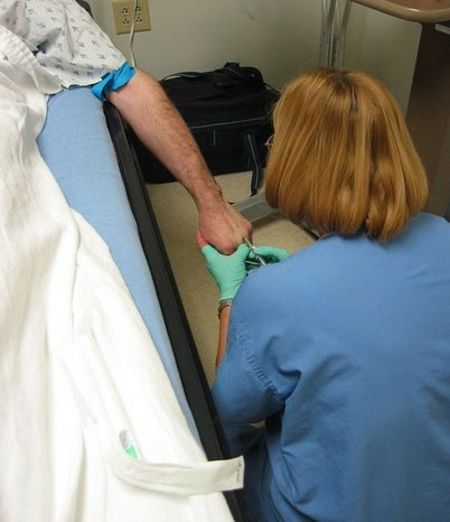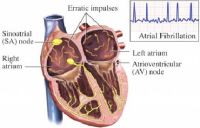A new technique of drawing blood from a patient using a modified intra-arterial (IA) line can reduce blood wastage significantly, according to a team of nurses from the intensive care unit (ICU) at Alexandra Hospital in Singapore. The modification adds a three-way tap and an additional syringe to the existing IA line kit.
“The additional syringe serves as a reservoir to collect fluid within the IA line kit. Instead of discarding the diluted blood within the kit (which was the case with the standard IA line kit), the new method allows us to return the blood to the patient without compromising its sterility,” said Advanced Practice Nurse Clarice Wee, who led the ICU team that developed the new method.
Ms. Wee's modification costs an additional 20 cents to the existing standard IA line kit which costs about S$10 each. An IA line is a small plastic tube (catheter) that is inserted into an artery, most commonly in the inner wrist. It is commonly used to monitor a critically ill patient’s blood pressure closely and draw blood samples frequently for tests.
Ms. Wee explained how a standard IA line works: “The IA line kit contains a column of saline called IV fluid. When blood is taken from the IA line, a small volume of blood, between 2ml to 5ml, is discarded to prevent the blood from being diluted with the saline. When this is repeated several times a day, these small blood losses add up to a significant loss.”
Each week, a critically ill patient might lose as much as 660ml of blood when it is drawn using a standard IA line. Of this, an estimated 18 to 30 percent is discarded during the blood-taking process.
An evaluation by Ms. Wee’s team on 50 ICU and high-dependency patients showed that the new method reduced blood wastage per blood draw to almost zero. ICU staff in AH are currently undergoing training to put the new blood-taking practice in place.
According to Dr. Jason Phua, respiratory physician and intensivist at National University Hospital (Singapore), blood loss from multiple blood tests is one of the reasons why critically ill patients are often anaemic.
“Severe anaemia is of concern for these patients because it results in a decrease in the delivery of oxygen to the vital organs and tissues,” Dr. Phua explained. “With severe anaemia, blood transfusions are required but they are sometimes associated with adverse effects such as fluid accumulation in the lungs and a weaker immune system. As such, interventions to minimise blood wastage in critically ill patients are most welcome.”
Closed system kits that reduce blood loss are available commercially but these kits, which have to be changed every 72 to 96 hours for infection-control purposes, can cost up to S$30 each, according to Ms. Wee.
Source: Alexandra Hospital
Image Credit: Wikimedia Commons
“The additional syringe serves as a reservoir to collect fluid within the IA line kit. Instead of discarding the diluted blood within the kit (which was the case with the standard IA line kit), the new method allows us to return the blood to the patient without compromising its sterility,” said Advanced Practice Nurse Clarice Wee, who led the ICU team that developed the new method.
Ms. Wee's modification costs an additional 20 cents to the existing standard IA line kit which costs about S$10 each. An IA line is a small plastic tube (catheter) that is inserted into an artery, most commonly in the inner wrist. It is commonly used to monitor a critically ill patient’s blood pressure closely and draw blood samples frequently for tests.
Ms. Wee explained how a standard IA line works: “The IA line kit contains a column of saline called IV fluid. When blood is taken from the IA line, a small volume of blood, between 2ml to 5ml, is discarded to prevent the blood from being diluted with the saline. When this is repeated several times a day, these small blood losses add up to a significant loss.”
Each week, a critically ill patient might lose as much as 660ml of blood when it is drawn using a standard IA line. Of this, an estimated 18 to 30 percent is discarded during the blood-taking process.
An evaluation by Ms. Wee’s team on 50 ICU and high-dependency patients showed that the new method reduced blood wastage per blood draw to almost zero. ICU staff in AH are currently undergoing training to put the new blood-taking practice in place.
According to Dr. Jason Phua, respiratory physician and intensivist at National University Hospital (Singapore), blood loss from multiple blood tests is one of the reasons why critically ill patients are often anaemic.
“Severe anaemia is of concern for these patients because it results in a decrease in the delivery of oxygen to the vital organs and tissues,” Dr. Phua explained. “With severe anaemia, blood transfusions are required but they are sometimes associated with adverse effects such as fluid accumulation in the lungs and a weaker immune system. As such, interventions to minimise blood wastage in critically ill patients are most welcome.”
Closed system kits that reduce blood loss are available commercially but these kits, which have to be changed every 72 to 96 hours for infection-control purposes, can cost up to S$30 each, according to Ms. Wee.
Source: Alexandra Hospital
Image Credit: Wikimedia Commons
Latest Articles
ICU, catheter, blood loss, anaemia, critically ill, blood taking
A new technique of drawing blood from a patient using a modified intra-arterial (IA) line can reduce blood wastage significantly, according to a team of nu...



























